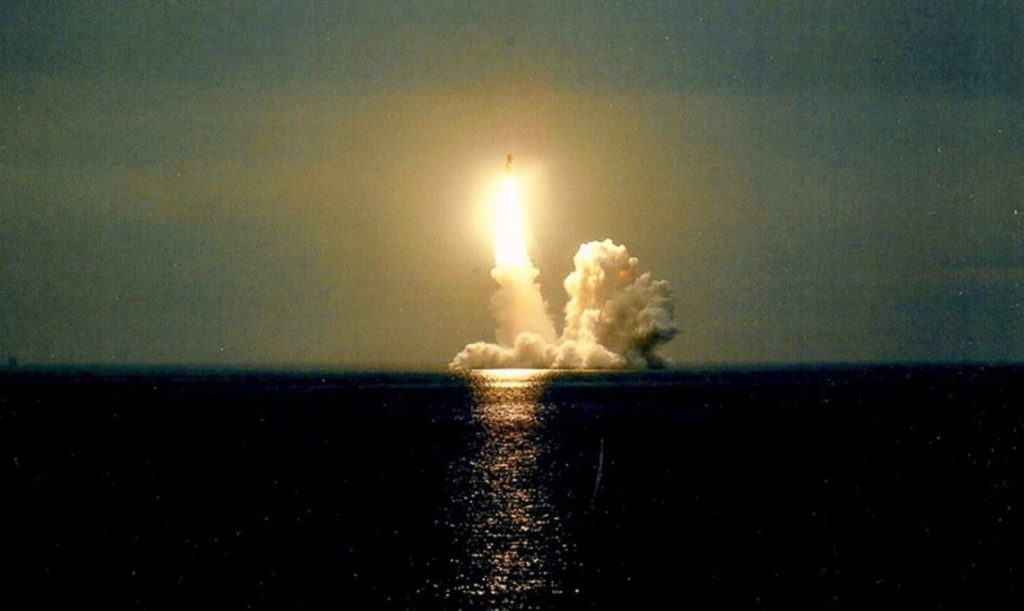Written by Andrei Akulov; Originally appeared on strategic-culture.org
The new Russian Bulava (RSM-56) intercontinental-range submarine-launched ballistic missile (SLBM) has entered service with Russian Navy to become the backbone of the nuclear triad’s sea-based component until 2040. It had not been a bed of roses. There had been ups and downs during the 20 years of hard work since 1998 to make it operational. 10 out of 32 tests conducted in the recent 14 years have failed. But it’s over now. The last salvo of four missiles launched in rapid succession within 20 seconds in late May was a great success demonstrating the weapon’s operational readiness. The designated targets at the Kura Missile Test Range located in northern Kamchatka in the Russian Far East were struck with high accuracy.
The Russian Navy operates Bulava with three of its latest missile Borei-class SSBNs (ship submersible ballistic nuclear) currently in service. The service plans to have eight boats of this class operational by 2021, with the newest five built in an upgraded variant to boast lower noisiness among other improvements.
One Borei-class (Project 955) strategic submarine can carry 16 SLBMs each armed with six to ten MIRVed (multiple independently targetable reentry vehicle) warheads with a yield of 150 kilotons apiece. A warhead can carry 10 to 40 decoys. With 8 Borei-class boats in service, Russia will deploy up to 128 Bulava missiles.
The weapon has a range of over 8,300 km with full load compared to US Trident II’s 7,800 km. The guidance is astro-inertial with the GLONASS satellite navigation system. The circular error varies from 120 m to 350 m, according to various sources.
The active trajectory leg is significantly shorter than that of its competitors to complicate the RSM-56’s potential interception. The flight trajectory itself is lower allowing the missile to cover the distance to the target faster and leaving the enemy less time to take a decision and react. The low trajectory allows the Bulava to classify as a quasi-ballistic missile due to its ability to perform maneuvers in flight and make unexpected changes in direction and range. Capable of changing the course in-flight and re-targeting to outmaneuver any ballistic missile defense (BMD), the re-entry vehicles are protected against both physical and electromagnetic-pulse damage to ensure that they can reach their targets intact.
The missile has the following specifications: a launch mass: about 36.8 tons, a throw weight: 1,150 kg, length: 12.1 m, a diameter: 2 m in a launch container. The RSM-56 can withstand a nuclear blast at a range of 500m.The Bulava is a three-stage missile with the first and second stages using solid fuel, while the third stage uses liquid fuel to increase maneuverability during warhead separation.
A submarine can fire the missile from an inclined position while on the move. A launch can be conducted from under ice as the Bulava does not require the submarine to surface and give away its position. Unguided munitions can be used for breaking the ice before the SLBM bursts through. This is an important advantage in comparison with the SLBMs Russia had before. This technology is the legacy of the Bark-class SLBMs that were scrapped in favor of Bulava missiles. The Borei-class SSBNs with stealth capabilities can stay underwater at the depth of 450 m for three months and then launch the missiles undetected. The Bulava missiles mounted on these submarines (the D-30 system) make possible the resumption of patrols in southern latitudes after the interval of more than 20 years.
The Russian Navy has been revived including all its branches but it but looks best underwater. With the Bulava in service, Russia has demonstrated that it has retained and advanced the industrial capacity and knowhow to produce SSBNs and SLBMs. The new boomers and missiles make up its naval nuclear strategic component. Suppose ground-based missiles and airfields are knocked out in a first strike though that one is more than a bit of a stretch. With eight Bulava-armed submarines, Russia will have at least two-three of them constantly on patrol at any given moment to constitute a more than credible deterrent. Retribution is unavoidable as the RSM-56 is practically immune to any imaginable BMD.
70 percent of the Earth’s surface is covered with seas and oceans, 80 percent of people live along coasts, and 90 percent of all world trade is carried by water to make this domain a potential source of conflicts. No pole in the multi-polar world can do without adequate sea power. Putting the Bulava to sea allows Russia to preserve strategic parity with the United States within the limits of the New START treaty as well as the status of global leader. The development and modernization of the maritime strategic nuclear forces is a must. Russia has coped with the task.







Southern latitudes? How southern?